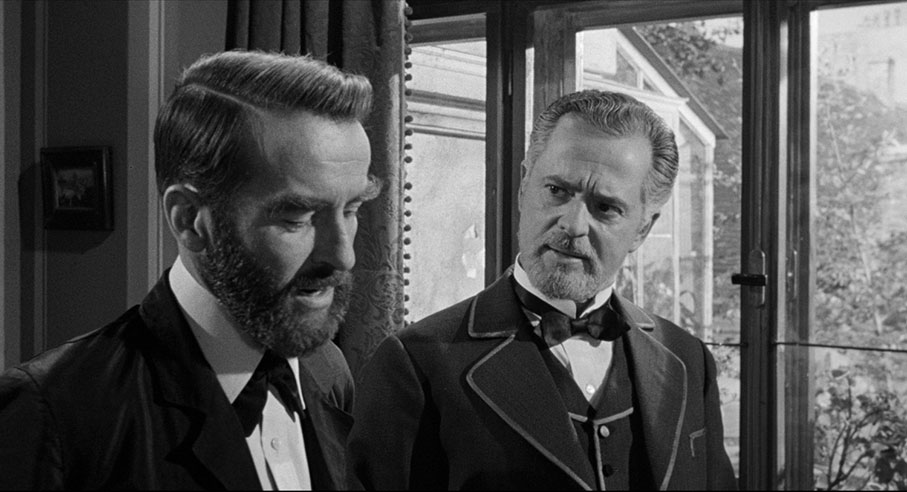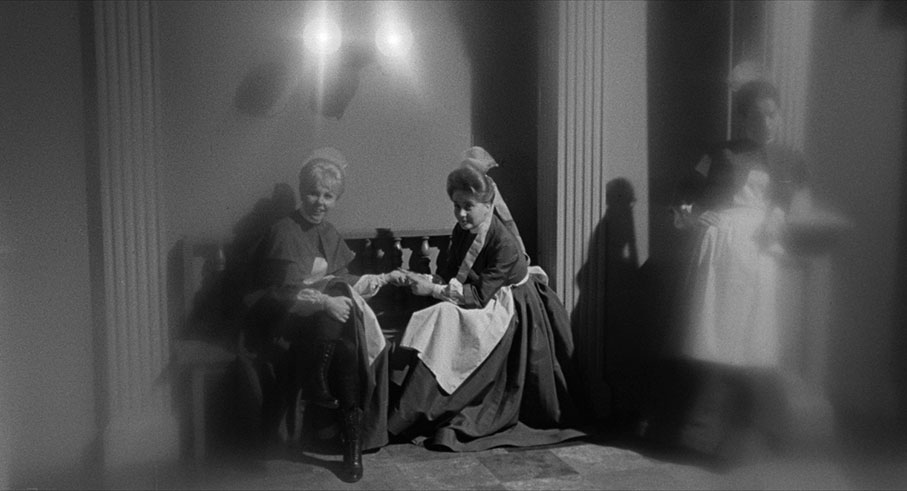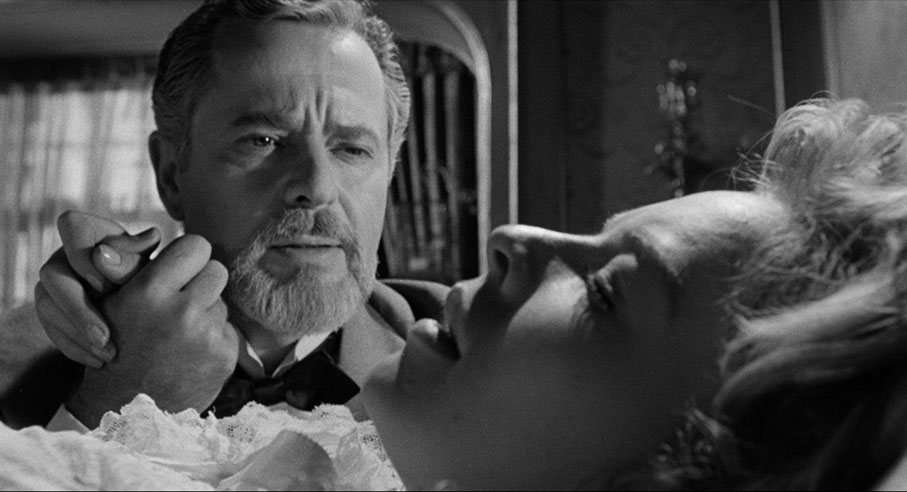|
Freud sets out its stall from the outset, as a narrator (an uncredited John Huston) places Sigmund Freud (Montgomery Clift) as the architect of one of the three main paradigm shifts for the human race, a change of how we saw the world and ourselves. First, Copernicus established that we weren’t literally the centre of the Universe, but a planet orbiting the Sun, in a cosmos with many other stars and planets. Then, Charles Darwin established that humanity is part of an evolutionary process and not spontaneously created by some god. And third of those three great men is Sigmund Freud. Whether people would elevate Freud to that extent nowadays is questionable. His place in the history of psychoanalysis is secure, and his influence on the field and on popular culture is undoubted, but later work in the field has built upon his work and at times demurred at some aspects of it, by feminists in particular. But with this film, John Huston gave the great man the biopic treatment, but in many ways it departs from the traditional model of such films. It’s one of Huston’s best works, if somewhat undersung nowadays. He had previously dealt with the subject of mental illness in his long-suppressed documentary Let There Be Light, of which more below.
Freud (which was released in some countries as Freud: The Secret Passion, the UK included, but this edition has just the single-word title) was a longstanding project of John Huston’s. Given the subject matter of Freud’s discoveries, in particular as they relate to sexuality, it’s hard to imagine such a film being possible in Hollywood much earlier than when Huston embarked on it, in 1958. In 1962, when the film was released, the major studios were still subject to the Production Code, but it was beginning to loosen and was five years away from being replaced by the ratings system we still have today.
When Huston began work on the project, he approached Jean-Paul Sartre to write the film. Sartre produced a treatment, which was accepted, but his complete script would have run about five hours. Asked to shorten it, Sartre sent in an even longer script. As a result, Sartre left the film and took his name off the credits, which list Charles Kaufman and producer Wolfgang Reinhardt, from a story by the former. However, some of Sartre’s work is still present. Even at two hours and twenty minutes, Freud does inevitably simplify the story, with the main patient Cecily Koertner (Susannah York) being a composite of several of Freud’s real-life cases. Filming took place in Vienna and studios in Munich, though despite the American production and European subject matter, many of the cast and crew were British.

Huston and his DP Douglas Slocombe shot Freud in black and white, which in 1962 was still a commercial possibility, and an obvious choice given the weighty subject matter and the historical setting. Yet, Freud is punctuated by several dream sequences, those of Freud and his patients. Dream sequences were not unusual for films with psychoanalytic subject matter: think for example of the Salvador Dali-designed one in Hitchcock’s Spellbound. There, Hitchcock and Dali went for a sharp clarity in the surreal imagery. Huston and Slocombe up the contrast, all inky blacks and blown-out whites with not much in between, and plenty of grain. These, and some flashbacks during treatment, feel like the eruptions from the unconscious they are meant to be, giving the film a super-real, at times disturbing edge. I’m not the first person to wonder if David Lynch had seen Freud before he made The Elephant Man, also in black and white but in Scope instead of 1.85:1 with a different DP (Freddie Francis), as many shots in that film resemble some from this, especially the scenes of Freud addressing his colleagues in lectures. Also, bearded, Montgomery Clift and Anthony Hopkins do resemble each other to some extent.
Huston had worked with Clift on The Misfits the previous year. Production was difficult as Clift’s health was suffering due to having become dependent on alcohol and pills following a terrible car crash in 1956. What also didn’t help was Huston’s homophobic reaction to finding Clift in bed with another man. Universal Studios sued Clift for frequent absences from the set, causing the film to overrun and go over budget. Clift countersued, citing considerable script revisions and an accidental blow to his head causing him cataracts. Clift also claimed that Huston bullied him on set, causing him to break down in tears on more than one occasion. (Susannah York corroborated this.) The case was settled out of court but Clift was effectively blacklisted, making one more film, The Defector, released in 1966 after his death that year, aged forty-five. With Freud, Clift had returned to a leading role after some years of taking smaller parts, in The Misfits and Judgement at Nuremberg (for which he was Oscar-nominated). You can sense a frailty and vulnerability in Clift’s performance, which is no doubt due to his circumstances, yet he does hold the screen, helping to convey the narrative of the formation of Freud’s ideas.
The original casting for the role of Cecily was another from The Misfits, Marilyn Monroe. However, Monroe turned the role down. This may have come to some relief to Huston’s long-standing script supervisor Angela Allen, who had clashed with Monroe on The Misfits, with Monroe claiming that Allen was having an affair with her husband. Susannah York was cast as Cecily. York, then twenty-two, had appeared in small roles on television and in such films as Tunes of Glory (playing Alec Guinness’s daughter) and a leading role in The Greengage Summer (aka Loss of Innocence). York made an immediate impact, picking up a Golden Globe nomination for her performance. She excels as a young girl, attractive to others (and who knows it) but is still a damaged person in need of healing. Her next film was the highly successful Tom Jones, setting her up for an often adventurous career, particularly in the later 1960s and 1970s. Rosalie Crutchley, who plays Freud’s mother, was actually only nine months older than Clift.

Another key contributor was Jerry Goldsmith, whose atonal score (with some electronic material by Henk Badings) earned him his first Oscar nomination. I’ve mentioned Slocombe’s cinematography, and the art direction (Stephen B. Grimes) and costume design (Doris Langley Moore) are also first-rate, very much part of the prestigious major-studio production this is.
The film ends with Freud presenting his ideas on infantile sexuality, in particular the soon-to-be-famous Oedipus Complex, to his colleagues, with the results being derision if not complete outrage. Yet, we know, Freud would be vindicated and take the place in history this film positions him for.
Freud was released in the USA on 12 December 1962, clearly placed as a prestigious awards contender. It received four Golden Globe nominations: as well as York’s Best Actress – Drama nod, it was also nominated for Huston as Best Director, Susan Kohner as Best Supporting Actress (as Freud’s wife Martha) and for Best Film – Drama. These didn’t overlap with the film’s two Oscar nominations, which were for the Story and Screenplay Written Originally for the Screen and for Goldsmith’s score, as mentioned above. However, in both awards ceremonies, Freud came away empty-handed.
Indicator’s release of Freud (spine number 259) is a single Blu-ray disc encoded for Region B only. Freud was given an X certificate – which then restricted audiences to those aged sixteen and over – on its UK cinema release in 1963 and it is now a 12. Let There Be Light has a PG certificate.
Freud was shot in black and white 35mm and this Blu-ray transfer, based on a 2K restoration by Universal, is in the intended ratio of 1.85:1. Douglas Slocombe was a master of black and white, and this transfer has blacks, whites and greys which are spot-on, with natural-looking grain. The dream sequences are, as mentioned above, deliberately harsher, grainier and contrastier than the rest of the film.
The soundtrack is the original mono, rendered as LPCM 1.0. Not much can be said except that dialogue, music and sound effects are well-balanced, clearly the result of old-school expertise in the Hollywood sound department. English hard-of-hearing subtitles are available for the main feature and Let There Be Light. I spotted one error, Breuer referring to the “morays” of society fifty-seven minutes in when that should be “mores”, but otherwise these are accurate.
Let There Be Light (57:54)
Let There Be Light is an appropriate film to include in this release as it marked the beginning of John Huston’s interest in psychotherapy (including hypnotism), which eventually led to his making Freud. This documentary was made in 1946, the last of four films Huston made while serving in the US Army Signal Corps during World War II. The film follows a group of servicemen as they undergo psychological therapy for what was often would be called nowadays post-traumatic stress disorder. Nothing was staged, with multiple cameras being used, though the editing sometimes leans towards film drama – note the dissolves during the scenes of soldiers having troubled nights. There is also a musical score by Dimitri Tiomkin. Over seventy hours of footage was shot, edited down to the present length of just under an hour. The script was co-written by Huston with Charles Kaufman (who would later co-write Freud) and Huston’s father Walter delivered the narration.
However, the War Department declined to release the film. The given reason was that it violated the privacy of the patients (rather similar to the reason for the non-military ban on Frederick Wiseman’s documentary Titicut Follies two decades later), though they had all signed releases which had been mysteriously lost. The real reason was likely that the Department wanted to maintain an image of their armed forces being strong and not as psychologically vulnerable as they are seen here. The ban lasted until 1981, when the film was shown at Cannes. In 2010 it was selected for preservation by the National Film Registry, after which it was restored.

Archival interview with John Huston and Montgomery Clift (13:32)
This audio-only item from 1961 (against a black screen) begins with a surprisingly visual reference, as “we” are looking at the building which was Freud’s clinic in Vienna. The unidentified interviewer gives a brief introduction, the film before his interviews with both Huston and Clift, recorded while the film was in production, begin. Huston talks about his interest in the subject of psychiatry having started with Let There Be Light, but he has not gone in for psychotherapy himself, relying on his neuroses to create. Clift talks about how he had to make changes in himself and says that psychotherapy would be a useful thing for actors before playing roles. The interviewer contrasts Clift’s “delicate, almost feminine” sensibility to Freud’s more aggressive father-based temperament, one which Huston clearly identified with.
Guardian Lecture with Susannah York (74:19)
This interview with York took place at the National Film Theatre (now the BFI Southbank) in 1982. The interviewer (male) isn’t identified on this disc. This is an overview of York’s career up to this point, though she does talk about Freud and her experiences on set, including her take on the conflict between Huston and Clift. She also says that Huston unsuccessfully tried to hypnotise her. (At least Huston didn’t go as far as Werner Herzog did with Heart of Glass and shoot the film with most of his cast under hypnosis.) What will be of interest is the discussion of some of the lesser-known works in her filmography. She seems particularly fond of the now-rare Country Dance, and she also talks about the Australian production Eliza Frazer, which didn’t have a UK cinema release. The sound quality is fine for the on-stage interview though questions from the audience aren’t always clear. As usual, illustrative film clips have been edited out. This item plays as an alternative soundtrack to the main feature, giving way to the film audio when it finishes.
Conflict and Trauma (28:57)
Matthew Sweet gives an overview of the film, beginning six years earlier with Montgomery Clift’s nearly fatal car crash on his way back from a visit to Elizabeth Taylor’s house, and she saves his life, preventing him from choking on dislodged teeth before the ambulance arrives. Later, John Huston meets Jean-Paul Sartre discussing the proposed film. They didn’t get on well, but Sartre does write a script, which was unusable as mentioned above. Sweet then discusses the psychodrama between Huston and Clift on set, with (according to Angela Allen) people divided between those sympathetic to Huston and those to Clift. Sweet talks a lot about Clift’s troubles on set – including boards as Clift had problems remembering his lines. As there is no commentary on this disc, which given the feature running time would be quite a lot of space to fill, this serves as a good substitute.
Theatrical trailer (1:15)
Howard Rodman trailer commentary (2:40)
There are two versions of the trailer here. Rodman’s commentary, from the Trailers from Hell series, is longer and uses the The Secret Passion subtitle. Over this, Rodman gives a quick overview of the film, from Huston’s initial work with Sartre, to Susannah York’s casting instead of Marilyn Monroe.

Image gallery
Eighty-nine images: stills, lobby cards, newspaper advertisements, the cover of Jerry Goldsmith’s soundtrack LP and posters from various countries, some of them using the The Secret Passion subtitle.
Booklet
A twenty-eight page booklet with this limited edition. It begins with “A Dream Project”, an essay by John Bleasdale, which begins by imagining what might have happened if Huston had ever been on Freud’s couch and suspects that the alpha-male Huston wouldn’t have submitted to it, however much the film was a personal obsession of his. Bleasdale discusses how Huston wanted to move away from a standard biopic approach for the film, even regarding it as “a species of thriller” and refers to the project’s roots in Let There Be Light. The essay covers the film’s production, from Huston’s conflict with Sartre and also with Clift. The latter sees as a very unfortunate match, that between a sadist and a masochist. He also sees the score, including electronic and industrial elements as it does, as another precursor of Lynch.
Next up is Huston’s director’s statement, included in the film’s press materials and also published in newspapers such as the New York Times. He says early on that cinema is closer to human thought processes than any other medium, hence his approach to the film’s subject matter. An extract from Huston’s autobiography An Open Book details his work with Jean-Paul Sartre. Huston had learned hypnosis when working on Let There Be Light – it features in some of the soldiers’ therapy - and managed to hypnotise Sartre’s secretary but failed to do so with Sartre himself. After falling out with Sartre, Huston went to work on The Misfits and returned to the project afterwards with Charles Kaufman reworking Sartre’s script. By then Sartre and Huston had fallen out completely. Sartre’s script was later published, as The Freud Scenario. After extracts from contemporary reviews of Freud, we have another extract from An Open Book, in which Huston talks about Let There Be Light, its making and its suppression by the War Office. The booklet also includes cast and crew listings and plenty of stills.
Freud remains one of John Huston’s best films, but it has been relatively undersung since its release sixty years ago. Indicator’s release is therefore welcome, with the inclusion of Let There Be Light being a bonus.
|